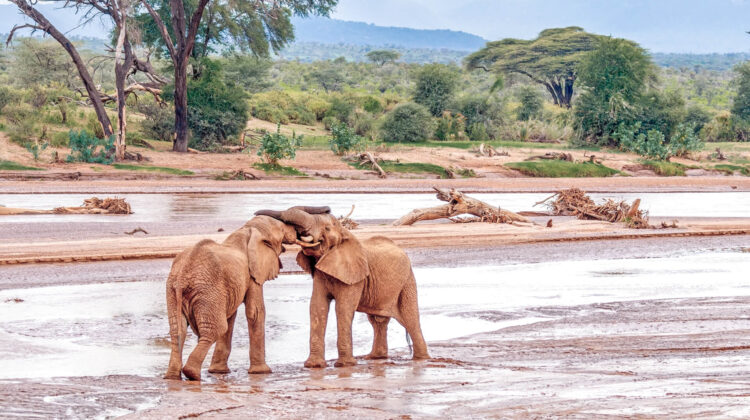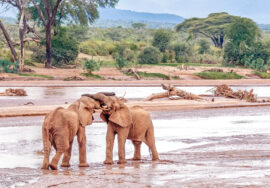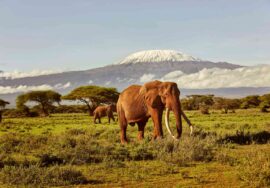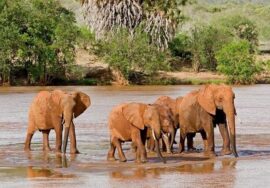
Samburu National Park
Samburu National Reserve | Adventure In The Wild Safaris
Location
Samburu National Reserve is located in northern Kenya, along the Ewaso Ng’iro River. The park is 220 miles or a six and a half hour drive from Nairobi. A flight from Nairobi’s Wilson Airport will take approximately 90 minutes, with guests flying into either Buffalo Springs, Samburu Oryx Airstrip, or Kalama Airstrip.
Size
The size of Samburu National Reserve is around 64 square miles.
History
Samburu National Reserve is the setting for the well-known book “Born Free,” Joy and George Adamson’s interactions and journey with Elsa the Lioness. In 1948, the reserve became a wildlife protected area and in 1963 was given to the African District of Samburu to administer. Today, the reserve is managed by local Samburu communities and stands as one of Kenya’s key safari destinations due to its size and great sightings of animals and birdlife.
Entrance Fees & Permits
The entrance fee to get into Samburu National Reserve is USD 70 per adult and USD 40 per child under 12 years old.
Hours of Operation
The gates of Samburu National Reserve are open from 6am to 6pm daily.
How to Get There
By Road
Travelling from Nairobi, the six and a half hour journey north takes visitors along the Thika and Nyeri Katerina highways. There are five gates into the reserve: Archer’s Gate (the most popular), West Gate, Kalama Gate, Uaso Bridge Gate, and Central Airstrip Gate.
By Air
Flights from Nairobi’s Wilson Airport take 90 minutes, with flights landing in Buffalo Springs, Samburu Oryx Airstrip, and Kalama Airstrip.
Best Time to Visit
Weather & Climate
Located in a partly arid and partly semi-arid climate, temperatures in Samburu National Reserve average between 65°F and 85°F throughout the year. Rainfall in general is low in the reserve, with the heaviest rainfall occurring in April and shorter rains in November. The dry winter months of June, July, and August provide the ideal time for optimal game viewing with low grass and crisp, clear days.
Avoiding Crowds
Winter is peak safari season in Samburu National Reserve, so planning a safari around the months of June, July, and August should be considered. This will ensure fewer vehicles out in the reserve and more availability in lodges and camps. Bird watchers will delight in visiting in January and February when the focus is on birdlife and newborns rather than intense wildlife encounters.
Value for Money
Accommodation in Samburu National Park ranges from budget camps to mid-range camps, and up to safari lodges and luxury accommodation in either tented or chalet-style setups. Pricing ranges from around USD 200 per person sharing per night to USD 1,000 per person sharing per night, with rates averaging approximately USD 700–800. With such a large rate scale, a value-for-money safari at Samburu National Park is definitely possible.
Wildlife and Landscape
Popular Wildlife Sightings
Samburu National Reserve is known for some of the best leopard sightings in Kenya and is home to unique wildlife such as the reticulated giraffe, Somali ostrich, and beisa oryx. The reserve is home to four of the “Big Five,” with rhino absent. Over 450 bird species have been recorded in the reserve, including the endemic vulturine guineafowl and Hunter’s sunbird.
The Terrain
The vast landscape of Samburu National Reserve comprises arid and semi-arid terrain, with the Ewaso Nyiro River running through the reserve, serving as a permanent water source. The land features valleys with shrubs, acacia trees, and palm trees scattered along the riverbank.
Experiences
Game Drives
Game drives typically occur early in the morning or late in the afternoon and last about three hours. 4×4 vehicles may be closed with a pop-up roof or open-sided with a roof cover. Qualified guides lead the drives in search of predators, prey, and birdlife.
Guided Walking Safaris
Enjoy a guided bush walk across the arid terrain and rock formations, with captivating views and encounters with birds and plains game like zebra and buffalo. Walks take place at sunrise or late afternoon when it’s cooler and average around 2.5 hours, with the option of a packed breakfast or brunch.
Camel Trekking Safari
A camel trekking safari is a unique way to explore Samburu, allowing for a slow-paced mobile tented adventure. View ostriches, giraffes, zebras, and more as you traverse the landscape on camelback.
Cultural Visits
Visit a Samburu village to learn about the rich heritage of the Samburu tribe, nomadic shepherds who are the third-largest Maa community in East Africa. Experience daily life and traditions of the Samburu people.
Reteti Elephant Sanctuary
Gain insight into local conservation efforts at Reteti Elephant Sanctuary, where orphaned elephants are cared for with the goal of eventual release back into the wild.








